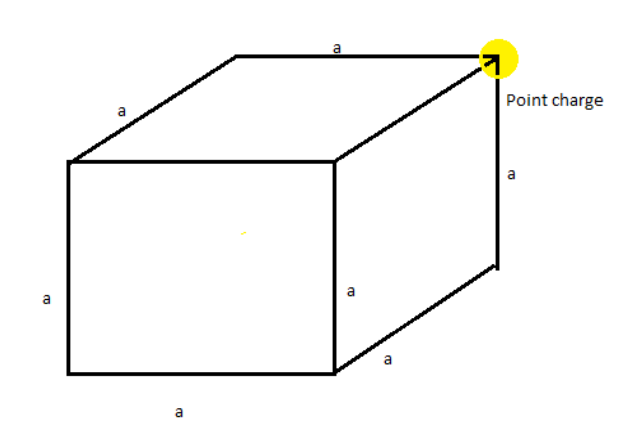
What is the flux through a cube of side ‘a’ if a point charge q is at one of its corners ?
A) \[\dfrac{q}{{{\varepsilon _\circ }}}\]
B) \[\dfrac{q}{{2{\varepsilon _\circ }}}\]
C) \[\dfrac{{2q}}{{{\varepsilon _\circ }}}\]
D) \[\dfrac{q}{{8{\varepsilon _\circ }}}\]
Answer
463.2k+ views
Hint: Electric flux is the rate of flow of the electric field through a given area. According to gauss law, the electric flux through a closed surface is equal to \[\dfrac{q}{{{\varepsilon _\circ }}}\], if q is the charge enclosed in it.
In case if a charge is placed at one of the corners of the cube then the amount of charge enclosed in it is eighth part of the charge so the flux is also the eighth part of \[\dfrac{q}{{{\varepsilon _\circ }}}\].
Formula used:
Gauss law: According to gauss law :- If a charge “q ” is enclosed in a closed surface then the net flux emerging out of the closed surface is \[\dfrac{q}{{{\varepsilon _\circ }}}\]. Gauss law is only applicable for closed bodies.
Complete step by step solution:
According to gauss law, the electric flux through a closed surface is equal to \[\dfrac{q}{{{\varepsilon _\circ }}}\], if q is the charge enclosed in it.

If the charge ‘q ’is placed at one of the corners of the cube, it will be divided into 8 such cubes. Therefore, electric flux through the one cube is the eighth part of \[\dfrac{q}{{{\varepsilon _\circ }}}\].
So electric flux (\[\varphi \]) is equal to \[\dfrac{q}{{8{\varepsilon _\circ }}}\].
Hence option (D) is the correct answer.
Gauss law is one of the four Maxwell’s equations which form the basis of classical electrodynamics.
Note: Electric flux has SI units of volt metres ( V m).
Electric flux is the rate of flow of electric field through a given area. Electric flux is proportional to the number of electric field lines going through a virtual surface. Gauss law can be used to derive the coulomb’s law and vice-versa.
In case if a charge is placed at one of the corners of the cube then the amount of charge enclosed in it is eighth part of the charge so the flux is also the eighth part of \[\dfrac{q}{{{\varepsilon _\circ }}}\].
Formula used:
Gauss law: According to gauss law :- If a charge “q ” is enclosed in a closed surface then the net flux emerging out of the closed surface is \[\dfrac{q}{{{\varepsilon _\circ }}}\]. Gauss law is only applicable for closed bodies.
Complete step by step solution:
According to gauss law, the electric flux through a closed surface is equal to \[\dfrac{q}{{{\varepsilon _\circ }}}\], if q is the charge enclosed in it.

If the charge ‘q ’is placed at one of the corners of the cube, it will be divided into 8 such cubes. Therefore, electric flux through the one cube is the eighth part of \[\dfrac{q}{{{\varepsilon _\circ }}}\].
So electric flux (\[\varphi \]) is equal to \[\dfrac{q}{{8{\varepsilon _\circ }}}\].
Hence option (D) is the correct answer.
Gauss law is one of the four Maxwell’s equations which form the basis of classical electrodynamics.
Note: Electric flux has SI units of volt metres ( V m).
Electric flux is the rate of flow of electric field through a given area. Electric flux is proportional to the number of electric field lines going through a virtual surface. Gauss law can be used to derive the coulomb’s law and vice-versa.
Recently Updated Pages
Preparation of Hydrogen Gas: Methods & Uses Explained

Polymers in Chemistry: Definition, Types, Examples & Uses

P Block Elements: Definition, Groups, Trends & Properties for JEE/NEET

Order of Reaction in Chemistry: Definition, Formula & Examples

Hydrocarbons: Types, Formula, Structure & Examples Explained

Classification of Elements and Periodicity in Properties | Trends, Notes & FAQs

Trending doubts
JEE Main 2025 Session 2: Application Form (Out), Exam Dates (Released), Eligibility, & More

Uniform Acceleration

Electric field due to uniformly charged sphere class 12 physics JEE_Main

Displacement-Time Graph and Velocity-Time Graph for JEE

Atomic Structure - Electrons, Protons, Neutrons and Atomic Models

JEE Main 2025: Derivation of Equation of Trajectory in Physics

Other Pages
JEE Advanced Marks vs Ranks 2025: Understanding Category-wise Qualifying Marks and Previous Year Cut-offs

Instantaneous Velocity - Formula based Examples for JEE

JEE Advanced Weightage 2025 Chapter-Wise for Physics, Maths and Chemistry

Ideal and Non-Ideal Solutions Raoult's Law - JEE

Learn About Angle Of Deviation In Prism: JEE Main Physics 2025

Wheatstone Bridge for JEE Main Physics 2025




